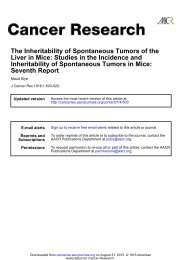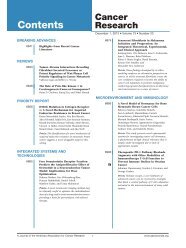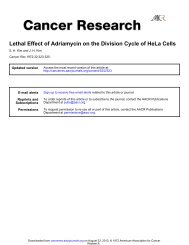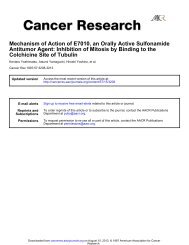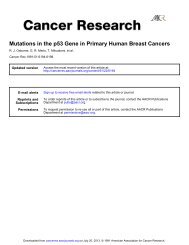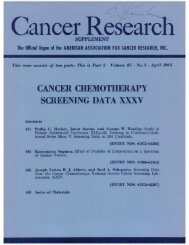MALIGNANT VARIANT OF CYSTOSARCOMA PHYLLODES ...
MALIGNANT VARIANT OF CYSTOSARCOMA PHYLLODES ...
MALIGNANT VARIANT OF CYSTOSARCOMA PHYLLODES ...
You also want an ePaper? Increase the reach of your titles
YUMPU automatically turns print PDFs into web optimized ePapers that Google loves.
<strong>MALIGNANT</strong> <strong>VARIANT</strong> <strong>OF</strong> <strong>CYSTOSARCOMA</strong> <strong>PHYLLODES</strong><br />
measuring 22 >! 12 cm. Included in the skin flap was the flattened pigmented nipple and<br />
expanded areola. The intact specimen weighed 3781 grams.<br />
The tissue cut with smooth but firm resistance, and a large quantity of pale serous and<br />
mucoid fluid escaped. The skin was edematous, being a full centimeter in thickness. The<br />
cut surface of the tumor was heterogeneous in appearance, uneven, grayish white in most<br />
areas, and a glistening, pale pink in others. In one section there were several cysts measur-<br />
ing 0.5 to 2 cm. in diameter. These did not have a lining membrane. One of them con-<br />
tained a pedunculated polypoid outgrowth. The tumor in general was irregularly lobulated,<br />
the lobules being encapsulated, firm, oval, and grayish white in color. Between adjacent<br />
lobules narrow clefts were observed. Breast tissue could not be identified grossly.<br />
Microscopic examination of the tumor shows two lesions; one a simple fibroadenoma.<br />
and the other the characteristic intracanalicular jelly-like growth to which the name cysto-<br />
sarcoma phyllodes is due. Reports on the microscopic diagnosis from a number of well<br />
known pathologists were somewhat divergent. They were carcinosarcoma, myxo-adenoma,<br />
adenocarcinoma, degenerating fibroadenoma, fibroadenoma with early carcinomatous<br />
changes, and finally, from four pathologists of large experience, cystosarcoma phyllodes.<br />
The structure does not differ greatly from other specimens of cystosarcoma as seen in large<br />
collections of tumor slides, or photomicrographs reproduced in various papers and textbooks.<br />
There is a jelly-like stroma containing large branching cells (Fig. 2) and cells with large<br />
irregular nuclei; numerous degenerated nuclei are also seen. Some of these cells have very<br />
largk cell bodies and unless one were familiar with the picture, the diagnosis of sarcoma<br />
would be suggested. In the original material there was no definite sarcomatous structure.<br />
Obviously there are groups of spindle-cells scattered about, but these are seen also in the<br />
tumors of patients who have been followed a sufficient length of time to say that no malignant<br />
change has occurred, or at least. after a simple mastectomy, that recurrence has not taken<br />
place.<br />
It is easy to see why one pathologist of somewhat limited experience made a diagnosis<br />
of early carcinomatous change. He was looking at the hyperplastic epithelium which lines




